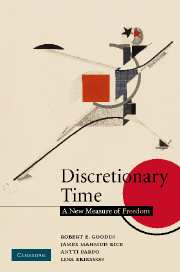Book contents
- Frontmatter
- Contents
- List of figures
- List of tables
- Preface
- Part I Introduction
- Part II Time pressure
- 4 Time pressure: a new problem?
- 5 Time pressure: a new measure
- 6 Is it really an illusion?
- Part III Welfare regimes matter
- Part IV Gender regimes matter
- Part V Household regimes matter
- Part IV Conclusions
- Appendix 1 Methodology
- Appendix 2 Data
- Bibliography
- Index
4 - Time pressure: a new problem?
Published online by Cambridge University Press: 28 October 2009
- Frontmatter
- Contents
- List of figures
- List of tables
- Preface
- Part I Introduction
- Part II Time pressure
- 4 Time pressure: a new problem?
- 5 Time pressure: a new measure
- 6 Is it really an illusion?
- Part III Welfare regimes matter
- Part IV Gender regimes matter
- Part V Household regimes matter
- Part IV Conclusions
- Appendix 1 Methodology
- Appendix 2 Data
- Bibliography
- Index
Summary
Whatever the objective facts of the matter – and they are controversial at least at the margins – it is nonetheless clear that people's subjective sense of time pressure has become increasingly urgent. Americans complain ever more stridently that they are ‘overworked’; the ‘leisure class’ that it is ‘harried’; working wives about their ‘second shift’ at home, and the ‘time bind’ that they suffer in consequence. President Clinton's Council of Economic Advisers pronounced the ‘time crunch’ to be real, and recommended a suite of policies to ameliorate it for the sake of America's families.
In this chapter we will briefly survey this ongoing discussion concerning the pressure on people's time, how it might have changed over the years and why. We are not particularly concerned to adjudicate those controversies here, however. Our principal focus in this book is not so much with history – distant or recent – as with the current state of affairs. In chapter 5 we will discuss how much time pressure different groups in society are suffering. We will go on there to discuss the extent to which that time pressure is inevitable or optional. Those analyses in chapter 5 thus constitute the empirical core of this part of the book, with the present chapter being merely intended to set the scene for what follows.
Time pressure in a broad historical perspective
Every generation thinks it is unique: uniquely cursed, or uniquely blest, or sometimes both at once. Is time pressure truly a uniquely contemporary phenomenon?
- Type
- Chapter
- Information
- Discretionary TimeA New Measure of Freedom, pp. 69 - 80Publisher: Cambridge University PressPrint publication year: 2008



